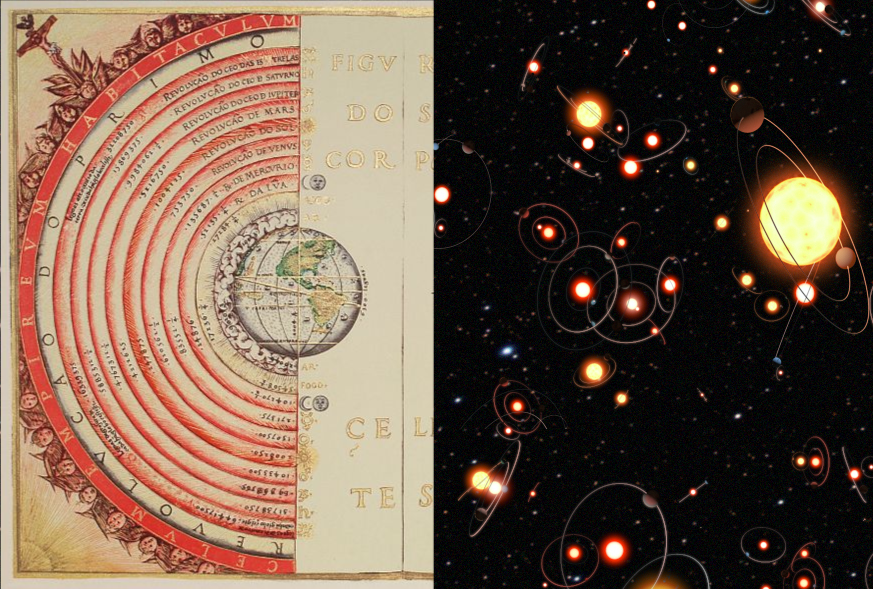
Seven Heavens and Extrasolar Planets

Australian skies look to the centre of the galaxy. The milky way is a bright band high overhead and the night sky an explosion of starlight. Distant and constant points of light, stars are infinitely older than our vanishingly brief time on this earth – so unconcerned with our petty happenings and trivial squabbles. They teach us a lot. Sadly in our modern world it has become harder to even see the stars. Certainly, their pristine glory is rarely seen, particularly if we live in one of the world’s megacities.
With an interest in the night sky, the following passage from Bahá’u’lláh’s writings is one of my favourites. Bahá’u’lláh is responding to a question he has received about the “celestial spheres”. The concept is an ancient and medieval scientific and religious model of the universe. Yet, Bahá’u’lláh’s response takes the questioner from medieval notions of celestial spheres to a model familiar from 21st century scientific investigation – extrasolar planets.
Thou hast, moreover, asked Me concerning the nature of the celestial spheres. To comprehend their nature, it would be necessary to inquire into the meaning of the allusions that have been made in the Books of old to the celestial spheres and the heavens, and to discover the character of their relationship to this physical world, and the influence which they exert upon it. Every heart is filled with wonder at so bewildering a theme, and every mind is perplexed by its mystery. God, alone, can fathom its import. The learned men, that have fixed at several thousand years the life of this earth, have failed, throughout the long period of their observation, to consider either the number or the age of the other planets. Consider, moreover, the manifold divergencies that have resulted from the theories propounded by these men. Know thou that every fixed star hath its own planets, and every planet its own creatures, whose number no man can compute.[1]
This passage is notable in a number of respects, including the gentleness with which Bahá’u’lláh draws thought from one way of thinking to an entirely different way of understanding the world. He does not reject the concept of “celestial spheres” (the received understanding for many centuries) but draws attention to other questions. While not elaborating his answer, the past is not thrown away; it has some presently relevant meaning that requires further thought. He alludes to the symbolic and mystical meanings connected with the concept. Thus, for example, we find the concept of seven heavens repeatedly referenced in the Qur’an.
Yet Bahá’u’lláh is not concerned with these questions here. Rather, he begins by calling into question another received wisdom – placing the age of the earth at a few thousand years. In the 19th century scientists were already establishing a much older age for the earth, yet these concepts were controversial (given religious orthodoxies of the time). If Bahá’u’lláh is alluding here to debates between theologians and scientists, he is taking a decided position against literalist readings of ancient religious texts – in this context, in application to scientific questions.
The manner in which he questions the conclusion is also interesting. It invites the reader to observe the universe – to consider the relationship between physical phenomena and draw enhanced understanding therefrom. Both observational evidence and reason are cited as tools for solving such questions. Further, the observation implies a model in which the earth is part of a broader unified system – the processes that generated the earth also generated the other planets. In these brief sentences we see in practice the principle of the harmony of science and religion, a core principle of Bahá’u’lláh’s teachings.
The final sentence of the passage reorients the vision of his questioner in an entirely new direction, and we are in the realm of 21st century science. In my own lifetime I am seeing these statements of Bahá’u’lláh being confirmed.
In the 1990s, not a single planet had been discovered outside our solar system despite decades of effort. Although many wondered, few boldly asserted the existence of planets beyond our own solar system. (A 1974 textbook Principles of Astronomy, by Stanley Wyatt, devoting around 200 pages to other stars, merely mentions in passing that Giordano Bruno was burned at the stake in 1600 for supposing that other stars were suns with planets like our own sun.) It was simply beyond what science was then able to observe.
Today, the evidence increasingly points to a conclusion that planets are universal. Based on Kepler surveys, scientists believe that nearly all sun-like stars have planets.[2] Further, from microlensing observations, scientists have concluded that stars “are orbited by planets as a rule, rather than the exception”.[3]
Science has yet to find life outside the earth, but there is increasing evidence to support the conclusion that it is, as a question of science, likely only a matter of time. The following is a brief summary of some of the relevant scientific findings. The requirements for life are in every solar system. Each has a ‘goldilocks zone’. Each is surrounded by an icy zone which is populated by comets and particles. Both are made largely of ice, but with the other essentials of life present. They are bombarded by powerful ultraviolet rays and become nurseries of complex hydrocarbons which are precursors of life. These comets and particles rain on the inner zones of solar systems. An increasing number of planets and moons have been found to have subsurface water oceans which may provide suitable habitats for life. Even planets extremely hostile to life (such as Venus) can have zones where life could in theory survive (high in its atmosphere in that case). Finally, our understanding of the ability of life to withstand extreme environments has extended the possible scenarios that can sustain life. We are still to reach definitive conclusions as to what life is, and so far we have only one example to consider – life on earth. The evidence is growing, but for the timebeing, we will have to wait and see what science reveals.
Image Credits: Composition of:
By Bartolomeu Velho – Own work, Public Domain, https://commons.wikimedia.org/w/index.php?curid=3672259
Extrasolar Planets By ESO/M. Kornmesser – http://www.eso.org/public/images/eso1204a/, CC BY 4.0, https://commons.wikimedia.org/w/index.php?curid=25936490
This article is the 27th in a series of what I hope will become 200 articles in 200 days for the 200th anniversary of the birth of Bahá’u’lláh. The anniversary is being celebrated around the world on 21 and 22 October 2017. The articles are simply my personal reflections on Bahá’u’lláh’s life and work. Any errors or inadequacies in these articles are my sole responsibility.








3 Comments
Michael Curtotti
Thanks Taeed
Dean Hedges
.
O my beloved! if thou didst know what God had ordained for thee, thou wouldst fly with delight and thy happiness, gladness and joy would increase every hour.
‘Abdu’l-Bahá
Taeed
Nice analysis of that famous verse!